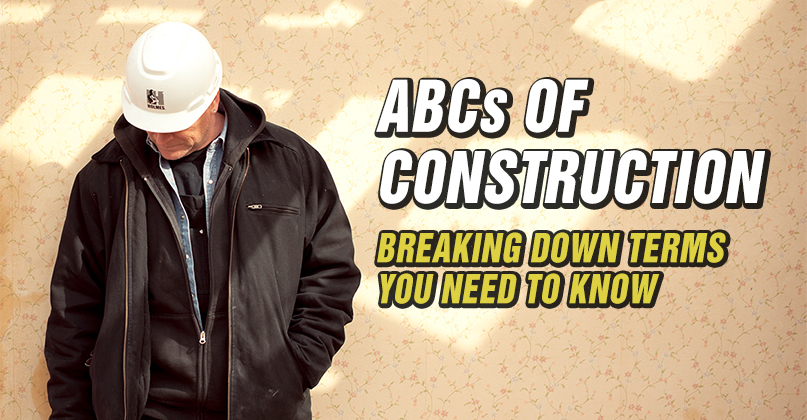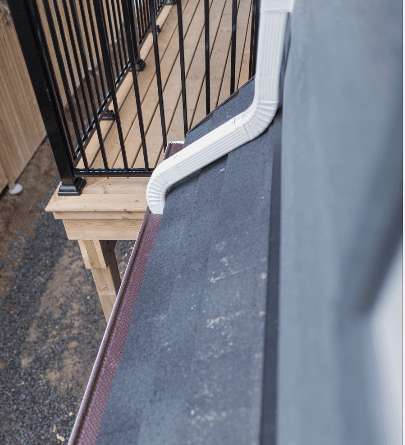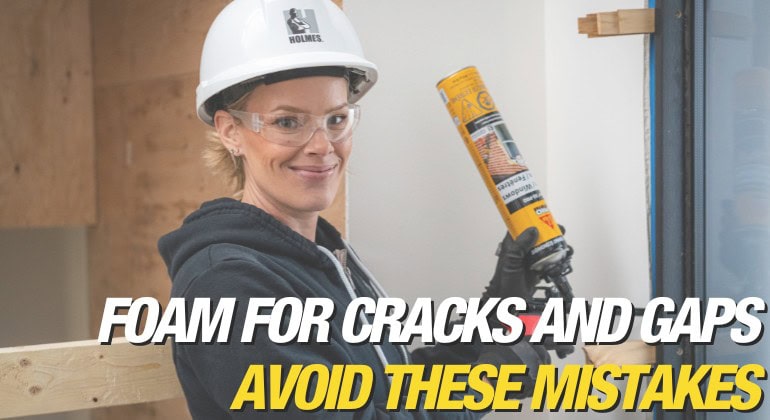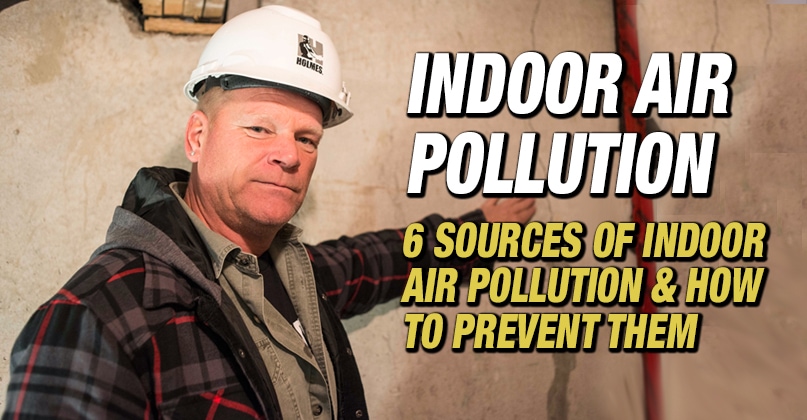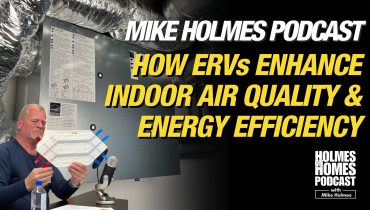I think custom kitchen cabinets are a great investment—but only if you do it right, the first time. Whether you’re renovating your forever home or boosting your home’s resale value,...

The ABCs of Construction
By Mike Holmes
Mike’s Advice / Home Safety & Maintenance
Monday, April 15th, 2019 @ 10:12am
Part of the reason I do what I do is so that homeowners are empowered to take a closer look at their homes and renovations, to make sure it’s being done right. When you do this as long as I have, sometimes you forget that not everyone has the same understanding of construction terms a contractor would.
What’s your home’s R-Value? Do you have a net zero home? Have you ever heard of an uncoupling membrane? I break down some common and not so common terms you need to know about your home.
Asbestos
Asbestos was a common building materials up until the 1980s – but if disturbed, it can be seriously harmful to our health. If you live in an older home and suspect asbestos – before you start demolition, have it tested.
Removing asbestos is not a DIY job. Always bring in an abatement specialist.
Building Envelope
Everything that separates and protects the interior of your home from the outside elements – which includes your roof, foundation, doors, and windows.
Crawl Space
Often found in homes without basements. Crawl spaces are shallow, unfinished areas below the home that allow access to wiring and plumbing.
Planning to make a change to your crawlspace? Start here.
Drainage
How your home deals with water. This is a complicated, but important process, that allows water to properly drain and vent from your home. Without proper drainage, you can have some serious water issues – which means things like mold and rot.
Eavestroughs
Gutters that hug tightly to your roofline that promote the movement of water away from your home and foundation.
Fascia and Soffit
Fascia and soffit are parts of your roof. The fascia refers to the horizontal band at the end of your rafters, and the soffit is located beneath your rafter tails.
Grading
Grading refers to the slope of your yard. You want your home to be graded in such a way that the ground near the foundation is higher than the ground further away. This lets water roll away from the home where it won’t do damage.
HVAC
Your home’s Heating, Ventilation, and Air Conditioning. I also like to call it the lungs of your home. Your HVAC is responsible for keeping your home nice and healthy throughout the year.
Do you know what’s in your furnace room? Find out here.
Insulation
Material that goes behind your walls to resist heat flow between the home and outdoors, avoiding air leaks and cold drafts. There are many different varieties of insulation on the market (blown-in, spray foam, rigid board) that each provide a different level of insulating power.
Joists
A collection of beams that support a floor or a roof.
Keeping Water Away
Water is your home’s #1 enemy. Your roof, your landscaping, your foundation all work together (or should work together) to divert water away from your house. Water intrusion can lead to very serious issues such as mold and rot. Read more about preventing mold growth here.
Lien
Construction liens are claims made against a property by a contractor. They’re designed to protect a contractor from the risk of not being paid for their services.
Check out our Lien On Me special.
Modular Homes
Modular building refers to a style of construction. Homes are built in an indoor, controlled environment, module by module, and when complete, are transported to a home’s final build site and fully assembled. Side-by-side you won’t be able to tell the difference between a modular build and an on-site build.
Watch below to see my talk about modular homes to a customer from Guildcrest Homes, one of the builders part of my Holmes Approved Homes program.
Net Zero
A net zero home generates its own power by harnessing a renewable source (solar, water, wind), and doesn’t consume any more energy than it is capable of generating on its own.
Want to learn more about net zero homes? Click here.
Outdoor Structures
Your deck, pool, shed, and other structures not found inside your home. Just because you’ve got an outdoor structure doesn’t mean you can skimp on the maintenance – they need just as much care and time as the interior of your home to stay strong.
- Learn how to maintain your outdoor structures
- Fix your home from the outside first. Learn how to take care of your home’s exterior.
Permits
Permits provide a record for your home that ensure any work done properly and safely. They’re also a valuable selling tool. When a homeowner is looking to buy, I always suggest they look into the permit record of a home.
Most projects will require a permit, especially if you’re touching something behind the walls (like your electrical). Not sure if your renovation requires a permit? It costs nothing to call and ask.
Quality of your Indoor Air
Did you know that the quality of your indoor air could be up to five times as polluted as the air outside your home? Your air could be polluted by harmful toxins like radon, lead, or VOCs.
R-Value
R-value refers to the ability a material has to resist heat flow. With a higher R-value, you’ll have more insulating power. Different areas of your home will have different requirements for how much insulation you’ll need.
Surge protectors
A power surge can strike randomly and at any time. Over time, this can cause major damage to our electronics. Surge protectors help keep our expensive products safe from the threat of power surges.
While most of us have surge strips to protect our electronics like TVs and computers – I recommend installing a whole home surge protector to cover everything, including your major appliances.
RELATED
Trusses
Trusses are a frame of the roof that bridge the space between the room below, and support the roof above.
Uncoupling Membrane
When you place tile directly over concrete, you’ll be prone to cracking. Why? When the concrete moves, it causes the tile to move with it, eventually leading to tile and grout cracking and following apart.
By installing an uncoupling membrane in between those two layers, the concrete will be able to move, without affecting the tile on top, cutting down on a major cause of cracked and broken tiles. Learn how to pick the right materials for your next bathroom remodel
Volatile Organic Compounds
Also known as VOCs are chemical byproducts found in many building supplies, products, and materials. They can off-gas in your home for years after installation, so new homes tend to have higher levels of VOCs than older homes.
Ways to improve your indoor air quality.
Weeping Tile
Also known as a drain tile. A perforated pipe placed underground next to your foundation to keep water moving away from your home.
X-Ray Vision
Having thermal imaging camera technology helps determine the energy efficiency for your home and checks for air and water infiltration. It’s like seeing your home through an x-ray. And all of Mike Holmes Inspectors are accredited Level 1 Thermographers.
Your Renovation Checklist
Hiring a contractor is the most important part of planning your renovation. Take your time and make sure they provide a proper contract. Here are my tips for hiring the right contractor.
Mike Holmes shares his advice on how to best prioritize your home renovations
Zoning
Dividing a home into zones based on usage. This makes your HVAC system more efficient by only heating certain areas of the home, instead of heating the whole home. Paired with digital thermostats you can control how much air flows – and where – throughout the day. That means, you can keep your bedrooms cool during the day, heat it up for about an hour before bed, and have it cool down again during the night.
READ NEXT:
